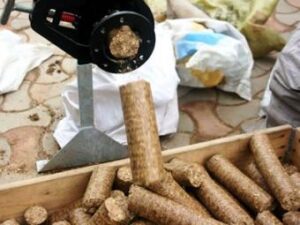Groundnut shell fuel briquettes are made from the discarded shells of groundnuts, which are available in large quantities in Gambia because of its groundnut industry. The briquettes have been pioneered by local businessman, Anthony Tabbal, and his briquette-making business was recognised in 2011 by the United Nations Environment Programme for its contribution to sustainable development. As well as manufacturing the fuel briquettes, Mr Tabbal also runs a restaurant in one of The Gambia’s leading areas for tourism. Ismaila Senghore went there to meet him, and began by asking what had motivated Mr Tabbal to make a cooking fuel from groundnut shells.
Tabbal: The main purpose why I started pressing groundnut shells was to find an alternative fuel. Most Gambians

rely on mainly wood fuels to cook with and charcoal. So the whole point of starting this project was to limit the use of firewood, because of course The Gambia is at a very vulnerable point now, with the amount of forest left. And of course also for financial gains. I started the company because I was spending so much money on firewood and charcoal and gas before. This was another point why I started to think about it, to find something that was cheaper and I ended up coming up with this solution. So the solution, I will start saving money when I am using it, and also saving our environment.
Senghore: Now I have just had a feel of the briquettes themselves as they came out of the machine. They look very smooth and shiny on the surface, and they look hard, hard on the touch, which means they will probably burn for a long time. Now where do you get the groundnut shells from?
Tabbal: I get them from the main dumping site where the Gambian Groundnut Corporation is dumping the shells. I go out there with my guys a couple of times a week. Pick up the shells, come back here and process them through the machine. We are doing about 600 kilos an hour. The hardness you saw, there was the machine compressing it, and when you heard the machine you heard this knocking sound. This knocking is hitting four times a second and every hit is four tonnes pressure and is going through a heated cone of 130 degrees. It’s just pressure and heat that does the job.


I ‘m very happy for your projet charcoal. because of you our environment wil be naturel.then i want to word with you in synegy. I make the charcoal briquette with the sawdust and biomass agriculture. I need the machin to press the briquette.Can you talk the price of and the place where i can by it?
I am camerouneen ( Bertoua)
Best regards
Zak
Dear Zak,
Thank you for your email. I suggest you contact a non profit organization in Cameroun called ACREST. http://www.acrest.org/
Good luck!
Dear sir, I am very much impressed with project. I wants to do this project in India, pls guide me how the detailed process and total investment. Thanking you
Dear sir
I am very much impressed with your project of making a charcoal from garbage. I also wants to do this project for rural people living in villages. These people generally uses the wood for cooking the food and boiling the water. Please let me know the detailed procedure for the production of this charcoal as well as machinery requirements.
Thanking you
Dear Dr. B R Shinde,
Thank you for your comment. Unfortunately, The Charcoal Project is not managing this groundnut briquette project. I suggest you try contacting the people and organization mentioned in the article for additional information. — The Charcoal Project
kindly send me the manufacturing process of the groundnut shell.
Let me know the ground nut shell making machine and what are the binders used to make the briquette. what type of machines required.
thank you
V.R.Kabadi
Dear V.R.Kabadi,
Unfortunately, we only published the article which appeared originally in another publication, for which you will find the link in the article. We did not report the story ourselves, so we are unable to provide you with contact information.
However, The Charcoal Project has recently co-launched a new website for the Harvest Fuel Initiative, a venture we co-spoons alongside MIT. You are welcome to ask questions on the Forum section and hopefully you will get some responses to your query.
Good luck!
Rgds,
The Charcoal Project
this is a very good project. i want to install a small project in our rural area, pl guide me for machinery required and min investment.
Dear Jayesh Nanera,
Thank you for writing. I invite you to visit us on the Harvest Fuel Initiative website for information and resources on how to start a similar project.
Best regards,
Kim
Briquetting plant is a renewable source of energy and it can covert all type of raw materials such as groundnut shells, almond shells, cotton salk, jute waste , bagasse, rice husk and forestry waste into efficient fuel briquettes. These briquettes are used in different types of industry as well as home for cooking..
Seriously, this is the best project to earn money and make our environment more greener and healthy.
It’s more economical friendly to make biomass fuels with agriculture waste and wood materials. Peanut shell is an ideal raw material. It has high cellulose and lignin content, so the molded briquettes or pellets are solid.